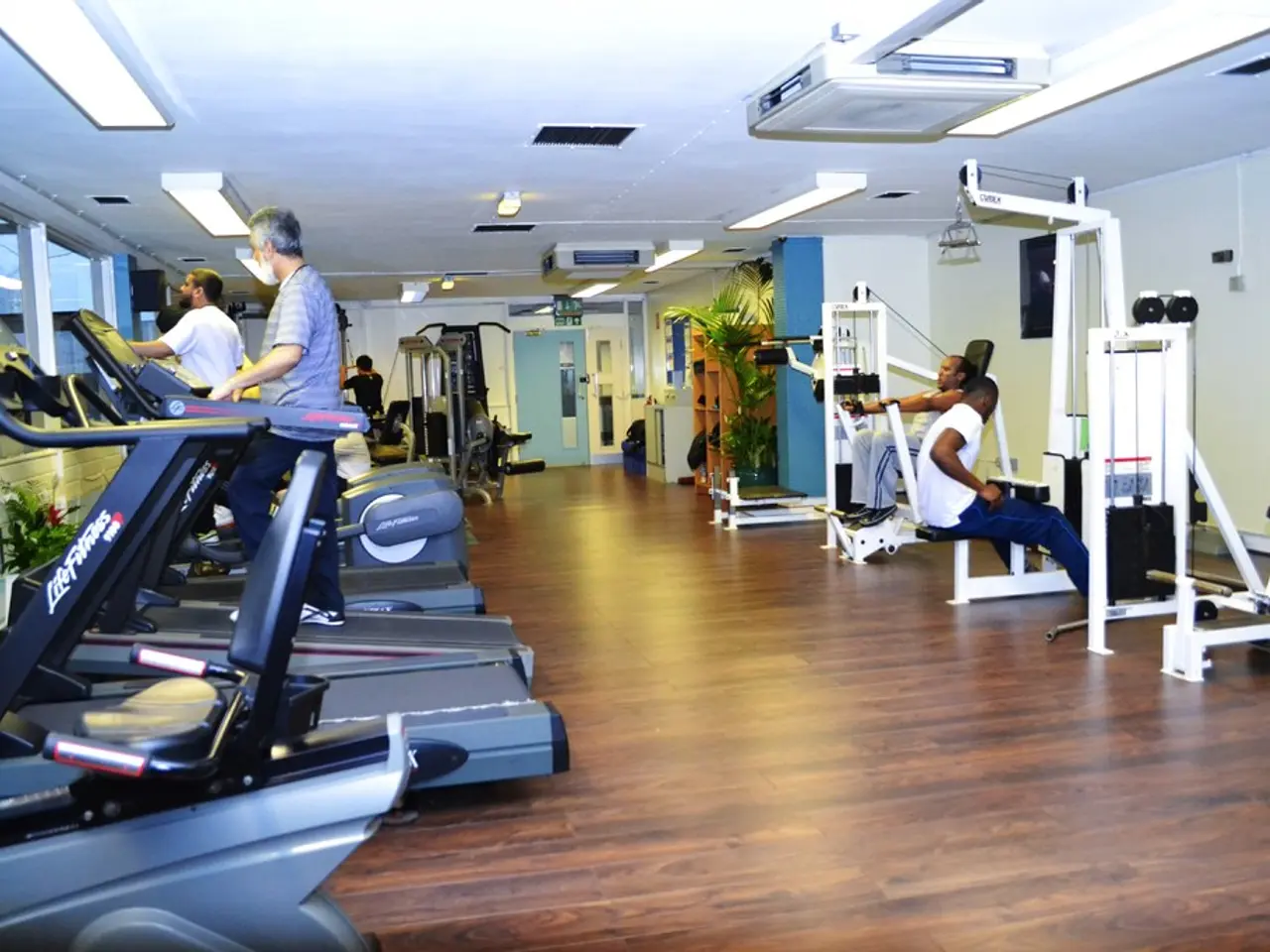The Nature of Physical Fitness Explained
Embark on a journey towards better health and well-being with a well-rounded fitness regimen. Regular exercise offers numerous benefits, from reducing the risk of falls and injuries to managing chronic conditions, and enhancing mental health and cognitive function [1][2][3][4].
The key to a successful fitness journey lies in a balanced approach, focusing on four main components: cardiovascular endurance, muscular strength, muscular endurance, and flexibility.
Cardiovascular Endurance
Aim for 150 minutes of moderate-intensity or 75 minutes of vigorous-intensity aerobic exercise weekly. Activities such as brisk walking, jogging, swimming, dancing, biking, hiking, or sports like tennis or pickleball are excellent options [1][3][5].
Muscular Strength
Strength training exercises targeting all major muscle groups are essential. This can include lifting weights, bodyweight exercises, resistance bands, or using weighted vests. Aim to engage in strength training at least twice a week [1][2][3][5].
Muscular Endurance
Muscle-strengthening workouts involving higher repetitions with lighter weights or bodyweight exercises repeated for multiple sets, such as multiple sets of 8 to 12 repetitions with rest in between, can help enhance endurance [1][2][5].
Flexibility
Incorporate stretching routines like static stretches, yoga, or mobility exercises to improve the range of motion around joints. Remember to avoid bouncing stretches to prevent injury [2][3][4].
Maintaining a healthy body composition is also crucial. A combination of aerobic exercise and strength training that increases muscle mass and reduces fat can help manage weight and improve proportions of lean mass to fat mass [2][5].
Incorporating rest days into your routine is essential for long-term success. Remember to celebrate small victories and stay on track towards your larger goals by tracking your progress [6]. Rewarding yourself for reaching fitness goals can serve as a powerful incentive [7].
Mixing up your workouts can help prevent boredom and maintain motivation. Engaging in regular physical activity has been shown to have positive effects on mental health, reducing symptoms of anxiety and depression, improving mood, and enhancing overall emotional well-being [8].
Physical fitness is a lifelong journey that can be adapted to suit any age or ability. You don't need a gym membership to be physically fit – activities like running, swimming, cycling, weightlifting, yoga, and team sports are all viable options [9].
A combination of both cardio and strength training is often the most effective approach for weight loss. Setting clear, achievable goals is essential for staying motivated, while surrounding yourself with inspiration can help maintain motivation on your fitness journey [10].
Remember, fat loss occurs throughout the body as a result of overall weight loss, not just from targeted exercises. Life can be unpredictable, and sometimes your fitness plan may need adjustments. Being flexible will help you maintain your commitment to physical fitness [11].
A physical fitness test is an assessment designed to measure various components of fitness, such as strength, endurance, flexibility, and body composition. Finding a workout buddy can provide support, encouragement, and hold you accountable for your fitness routine [12]. To obtain a physical fitness certificate, you typically need to complete a fitness assessment or test through a recognized organization or fitness center [13].
Lifting weights helps build lean muscle, which can enhance your metabolism and improve overall body composition. Improving physical fitness can be achieved through a combination of regular exercise, a balanced diet, and adequate rest [14]. Low-impact activities such as walking, swimming, or yoga can be particularly beneficial for older adults [15].
Stay committed to your fitness journey, and remember that it's all about finding what works best for you. Embrace the journey to a healthier, happier you!
[1] American Heart Association. (2020). Physical Activity Guidelines for Americans, 2nd ed. U.S. Department of Health and Human Services. [2] Mayo Clinic. (2020). Fitness: Improve your health and well-being with regular exercise. [3] Centers for Disease Control and Prevention. (2020). Physical Activity for Everyone. [4] National Institute on Aging. (2019). Exercise and Physical Activity: Your Everyday Guide from the National Institute on Aging. [5] World Health Organization. (2020). Global Recommendations on Physical Activity for Health. [6] American Psychological Association. (2018). The benefits of setting and achieving goals. [7] Psychology Today. (2017). The Power of Rewards: How to Motivate Yourself to Exercise. [8] Harvard Health Publishing. (2019). Exercise: A Mood Booster. [9] President's Council on Sports, Fitness & Nutrition. (2019). Fitness: Find Your Way to Play. [10] American College of Sports Medicine. (2018). ACSM's Guidelines for Exercise Testing and Prescription. [11] American Council on Exercise. (2019). Flexibility Training: The Importance of Stretching. [12] National Academy of Sports Medicine. (2019). NASM's Essentials of Personal Fitness Training. [13] American Council on Exercise. (2019). ACE Certified Personal Trainer Manual. [14] American College of Sports Medicine. (2016). ACSM's Resource Manual for Guidelines for Exercise Testing and Prescription. [15] National Institute on Aging. (2017). Exercise for Seniors: A Guide from the National Institute on Aging.
Health-and-wellness and fitness-and-exercise play significant roles in the journey towards better health and well-being by enhancing both physical and mental health. A balanced fitness regimen focuses on four main components: cardiovascular endurance, muscular strength, muscular endurance, and flexibility, as specified by the American Heart Association and other health organizations.





